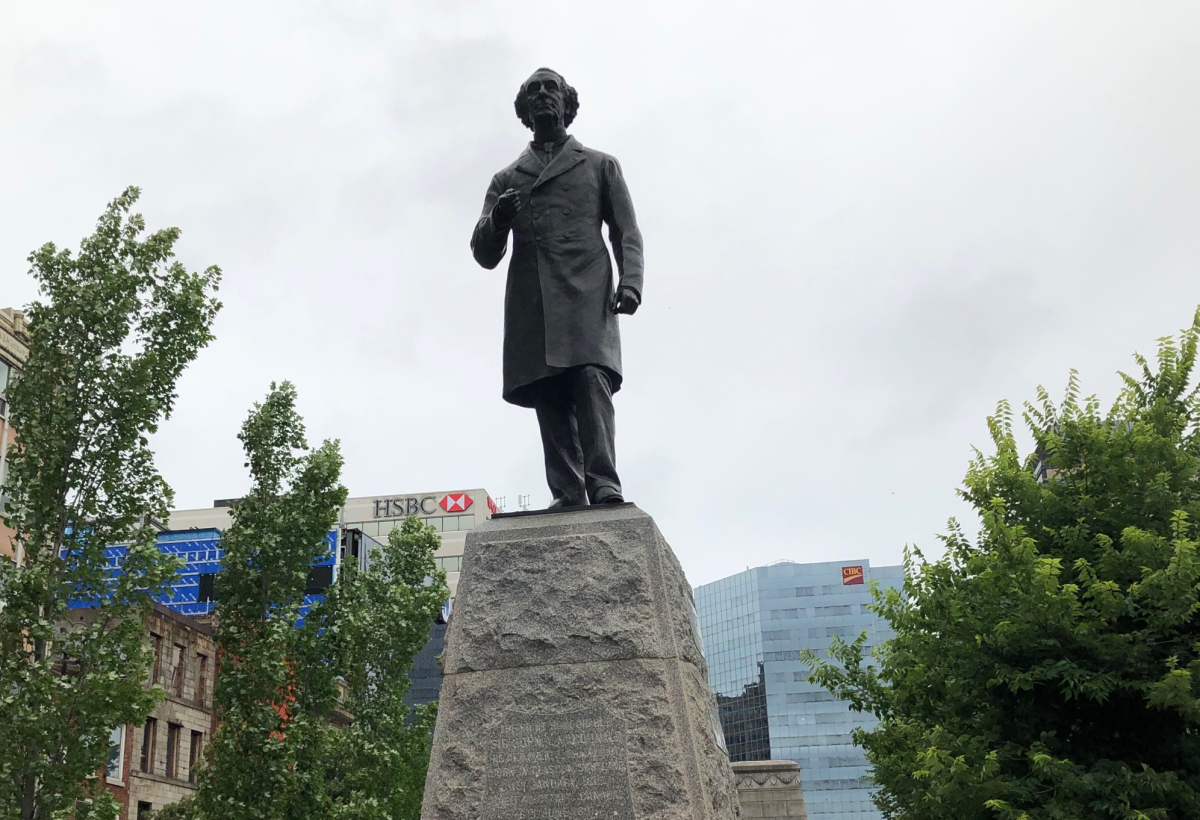Hamilton city council has upheld a committee vote against removing the Sir John A. Macdonald statue from Gore Park in the city’s downtown core.

Only three councillors voted in favour of taking down the statue following ongoing calls from local Indigenous residents, who say the statue of Canada’s first prime minister is a source of pain and harm for them.
It was a vote of 12-3, with councillors Nrinder Nann, Maureen Wilson and Brad Clark in favour, while everyone else voted against.
Nann, who moved the motion, had urged her fellow councillors to support it, saying the city must do more to support the Indigenous community in the wake of discoveries of unmarked graves at residential school sites across Canada.
“By not removing the statue, unfortunately, what we will be doing is saying to Indigenous people across Turtle Island that this Hamilton City Council expects you to continue to endure pain, and trauma, and harm,” said the Ward 3 councillor.
Although that motion was defeated, there was unanimous support among councillors for a review of Hamilton’s landmarks and monuments, which is expected to cost about $75,000 and will be covered by the tax stabilization fund.
Many councillors, including Ward 6’s Tom Jackson, said they did not want to see the statue taken down before the city has a chance to complete that review.
- Trudeau tight-lipped on potential U.S. TikTok ban as key bill passes
- Canadian man dies during Texas Ironman event. His widow wants answers as to why
- Hundreds mourn 16-year-old Halifax homicide victim: ‘The youth are feeling it’
- On the ‘frontline’: Toronto-area residents hiring security firms to fight auto theft
“I want to give this report a chance,” said Jackson. “To remove anything right now, as this motion is before us, to remove anything right now, to me preempts the opportunity of this landmarks and monuments review.”
He also expressed concern that removing the Macdonald statue would create a “domino effect” of other monuments being the subject of scrutiny.
That was a concern echoed by other councillors, including Ward 10’s Maria Pearson.
“Today it’s Sir John A. Macdonald and Ryerson. Tomorrow, it could be Queen Victoria, it could be Laurier, Mackenzie, MacNab. It could be the naming of streets. There’s so many things and so many implications of what decision is made today.”
Other Canadian cities like Kingston and Charlottetown have removed their statues of Canada’s first prime minister in recent weeks in light of his role in establishing the country’s residential school system and the damage that his policies have done to Indigenous people.
Ward 9 Councillor Brad Clark said he supported the statue being temporarily put into storage while the monuments review is underway as a gesture of “good faith” ahead of consultations with Indigenous residents.
He also referenced the statue, which was erected in Hamilton in 1893, as being a target of vandalism if it remains standing.
“My fear is that someone is going to, in the dark of night – and it has been vandalized a number of times already – is going to pull it down. And that statue could be damaged significantly, and the cost would well exceed what we were going to spend just to put it in secure storage so that we know where it is and that it’s safe.”
In recent weeks, the statue has been splashed with red paint on one occasion and was covered up with a black cloth and red rope on another occasion.
Hamilton police chief Frank Bergen said there will be mischief charges for anyone who damages the statue.
“When we hear about actions … such as defacing a statue or looking at some type of response, we have used our police liaison team approach, who then work with the organizers,” said Bergen during an interview on Global News Radio 900 CHML’s Bill Kelly Show.
He referenced the statue being “shrouded” with the black cloth and red rope as one time when the service worked with demonstrators to prevent the statue from being defaced.
“And on top of that, 215 silhouettes placed in the forecourt of city hall. That is a respective reminder for us to understand the impact of what is going on with regards to residential schools, but as a community, this is a larger discussion. We may play a role – our role is to keep the peace, it’s community safety.”
Another motion from Thursday’s emergency and community services committee that called for the renaming of the Ryerson recreation centre in the lower city was defeated during Friday’s council meeting.
That motion from Ward 1 Councillor Maureen Wilson follows trustees with the Hamilton-Wentworth District School Board unanimously voting to rename Ryerson Elementary School last month, moving away from the name of Egerton Ryerson, who was an architect of the residential school system.
It was defeated 11 to 2, with only Wilson and Nann voting in favour, and ultimately referred to the city’s facility naming subcommittee.
While speaking in defence of the motion to remove the Macdonald statue, Wilson said reconciliation is about listening to Indigenous people when they speak about the harms they continue to experience.
“And we’re not prepared to do that, it seems,” she said. “Because we have a process.”
“We’ve been telling Indigenous peoples across this land that we have a process, a process that they have never created or been empowered to define, but we have a process. Just wait for it.”
The Indian Residential Schools Resolution Health Support Program has a hotline to help residential school survivors and their relatives suffering with trauma invoked by the recall of past abuse. The number is 1-866-925-4419.




Comments